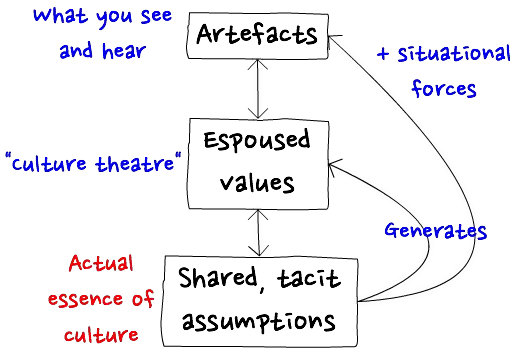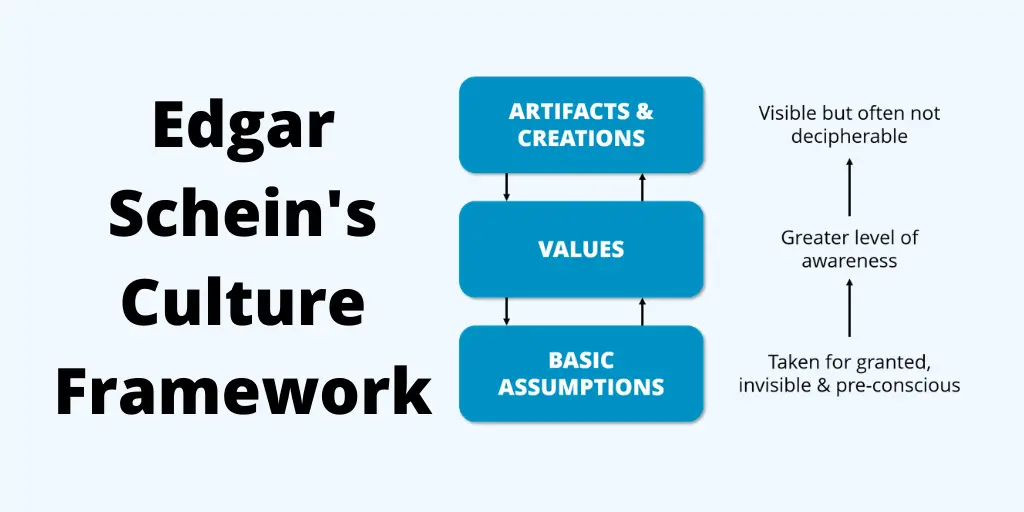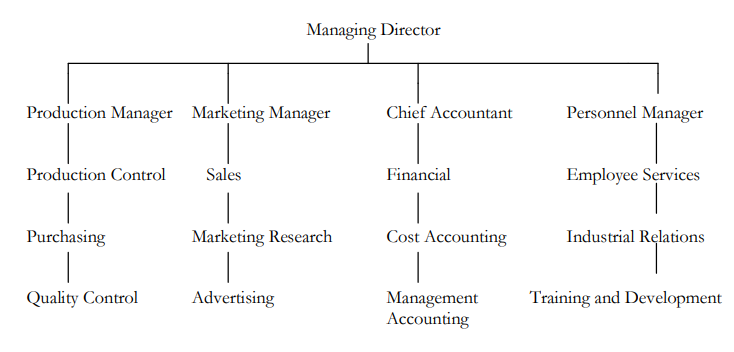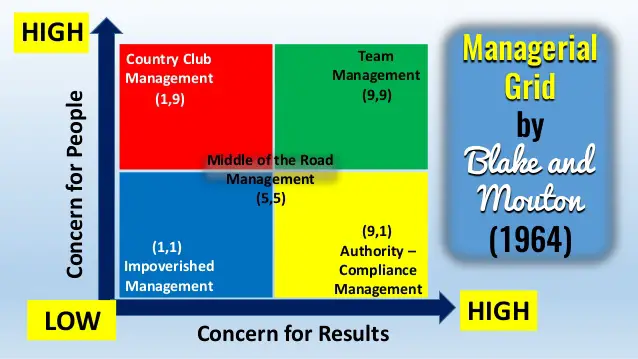Edgar Schein Organizational Culture Model | Artifact Values |Espoused Values| Assumptions of Organizational Culture
Edgar Schein Organizational Culture Theory
Edgar Schein‘s organizational culture model was first developed by Edgar Henry Schein at MIT Sloan School of Management in Massachusetts, USA, in 1985. Edgar Schein identified a model of an organizational culture where the basic assumptions shape values and the values shape practices and behavior, which is the visible part of the culture.
He proposed three distinct levels in organizational cultures: artifacts and behaviors, espoused values, and assumptions, which came to be known as Edgar Schein’s three organizational culture levels.
Schein organizational culture and leadership
Organizations do not adopt a culture in a single day and, in fact, learn from past experiences and start practicing it every day, thus forming the culture of the workplace.
Edgar Schein’s theory is what we call the functional perspective, where culture serves as a particular function in the organization. He proposed two functions.
The first is to create a community among the employees to create a pleasant atmosphere in the daily work.
The second is to adapt the organization to the external surroundings to survive and grow.
In Schein’s understanding of culture, there is no difference between talking about an organization or a group. Culture occurs between a larger or a smaller group of people who have something in common. Whether you call it an organization or a group does not matter in this context
The way the organization’s staff and employees act concerning values, norms, and terms define the organization’s culture. Culture is thus a way of explaining the organization’s being.
Schein offers the following definition of organizational and group culture;
💥🎁 New Year & Easter Deals On Amazon !
Don't miss out on the best discounts and top-rated products available right now!
🛒 Shop Now and Save Big Today!*As an Amazon Associate, I earn from qualifying purchases.
A pattern of shared basic assumptions that the group learned as it solved its problems of external adaption on internal integration. that has worked well enough to be considered valid and, therefore, to be taught to new members as the correct way to perceive, think, and feel in relation to those problems.
As a functionalist, Schein thus regards culture as something that is everywhere in the organization and characterizes its members. According to this theory, culture is a metaphor for the organization of the company.
Edgar Schein Three Levels Of Culture
Edgar Schein divides culture into three levels.
- The upper level is artifacts and behaviors that are visible.
- The middle level is espoused with less visible values.
- The lowest level is basic assumptions, which occur at the unconscious level among the members, and are thus invisible.

Edgar Schein Iceberg Model or Edgar Schein Onion Model
The model is also called the Edgar Schein iceberg model. Like an iceberg, the lower part is hidden; only approximately 10% is visible above the water surface. Also referred to as Edgar Schein Onion model because it looks like a bulb onion.
Schein Artifact Values of Organizational Culture
At the upper level, we have artifacts and behaviors. Artifacts are the first thing you will notice when you visit a company for the first time. They are both from the outside and when you enter the company. The company’s buildings and facade, the logo, the way employees dress, the interior design such as furniture selection and deck, or the art on the walls, the reception desk, and the way the front staff receives you.
This physical evidence is an essential part of the artifacts, and the way the employees talk to each other and how they speak to you in person and on the phone is part of the artifacts.
The artifacts provide an insight into how the organization wants to appear at first sight and how it appears to you. Artifacts are thus visible organizational structures and processes that are easy to observe but difficult to interpret.
The interpretation of artifacts is subjective, and we look at them from our point of view. We relate them to our world of life and associative values.
Espoused Values of Organizational Culture
At the next level, we have espoused values. They are the organization’s stated values and norms and present and form rules under which the organization works. The management of the company determines the values and form of the framework for the work.
These values include, for instance, the company’s website, the organizational structure, annual reports, brochures, and other written materials. The espoused values are thus the expressed publicly announced principles and values that the organization members claimed to live by.
Sometimes the visitors to the company will wonder about meeting different values set on the first two levels, for instance, if the company website expresses an exclusive style and design, but the visitor is met by mess and disorder when visiting the company.
💥🎁 New Year & Easter Deals On Amazon !
Don't miss out on the best discounts and top-rated products available right now!
🛒 Shop Now and Save Big Today!*As an Amazon Associate, I earn from qualifying purchases.
Basic Assumptions of Organizational Culture Theory
At the bottom level, we have the basic assumptions of the company. This level represents the core of the organization.
If a basic assumption is firmly rooted in the team, group members and will perceive any behavior based on any other basis as incomprehensible.
Basic assumptions are routines and norms in everyday life that we neither challenge nor debatable, therefore, extremely difficult to change. This is where culture has real power.
Correlation Between Schein Three Levels of Organizational Culture Theory
There is a correlation between the three levels. The arrows on the diagram below show that if the values expressed are consistent with the basic assumptions, then these are actual values.

Suppose there is no consistency in the values at the individual levels. In that case, the organization has a problem where employees do not thrive and where surprises emerge for customers and other partners as they get to know the company.
Therefore, it is essential to compare the expressed values with the basic assumptions when analyzing a given culture.
How to Apply Schein Model as An Analysis Tool.
Organizational culture can be considered as an important tool for managers. A leader can consciously influence the culture in the desired direction. Here are key points to consider in each level of Schein Model’
Schein Artifact Examples
When looking at the artifacts values, the key pointers are;
- How do we talk together?
- How are we dressed?
- How is our office environment?
- What is the attitude of the workers?
- Is there anything different from what the manager thought it would be?
Artifacts are the visible surface but essential for the manager to note. The objects are what customers, suppliers, investors, and visitors see when visiting the company.
💥🎁 New Year & Easter Deals On Amazon !
Don't miss out on the best discounts and top-rated products available right now!
🛒 Shop Now and Save Big Today!*As an Amazon Associate, I earn from qualifying purchases.
If something should change, then the leader must descend into the other levels.
Espoused Values Example
We look at things like;
- What declared values do we have?
- What do we write on our website?
- How are our mail or Internet communications?
- What are our written rules?
The manager or the person must do this cultural analysis to notice if there is a difference between what people say and what they are doing on what they actually are doing.
Here you see the company’s official image, and If this analysis shows that a change is needed, then the next step is to look at the basic assumptions.
Schein Basic Assumptions Examples
The last step is basic assumptions. To make a change, the basic assumptions that exist in the company must be taken into account. You look at;
- Behavioral traits, the language they use, the customs and traditions that evolve, and their rituals in widely different situations.
- Group norms, the implicit standards, and values that developed in working groups. For example, ending the workday at 4 p.m. regardless of whether the orders are delivered even though one of the companies expressed values is on-time delivery.
- Game rules the organization’s implicit rules, the scams that a newcomer must necessarily learn to be accepted as a member.
- The climate in the group; the mood created in a group by the physical framework and by the way members of a group interact with each other and others.
Organizational Culture Over Strategy
Everything that happens within the company is based on the organization’s basic assumptions. It is difficult for employees and managers to see the basic assumptions because they are so much a part of everyday life.
That is why it is difficult to change strategy when it involves changing basic assumptions in the group or the entire organization.
The arrows here show that the basic assumptions spread to other levels in the organization and become visible to customers, suppliers, and other relevant business partners in the long run.

When change processes get off track, it is more often than not because you forget to take into account the third level of Schein’s model; The basic assumptions.
💥🎁 New Year & Easter Deals On Amazon !
Don't miss out on the best discounts and top-rated products available right now!
🛒 Shop Now and Save Big Today!*As an Amazon Associate, I earn from qualifying purchases.
The process often fails because management has only taken into account the behavior and values that are visible and has therefore planned a process that goes against the organization’s culture, and then culture wins over strategy.
Edgar Schein Model of Organizational Culture Examples
The Danish company Vola, which produces kitchen and bathroom fittings, has successfully worked on cultural change in the company to move from technician culture to designer culture.
The company’s salespeople were rooted in quality fitting and had a strong focus on the technology and facts about the products in the sales process.
Vola fittings are of high quality on additionally unique in design made by the well-known designer Arne Jacobsen.
The problem occurred with the emergence of several competitors who produced and sold fittings of a similar model at a lower price.
Customers could not immediately see the difference between the original and copied fitting, and even though Vola worked to protect the rights and was legally after the competitors, it’s still influenced the sale of Vola fittings negatively.
Vola sales People were aware of Arne Jacobsen’s design, but they were used to thinking about facts and product specifications.
The management of Vola decided to change the company’s culture from being a technician culture to a designer culture.
They initiated a change process during the following mission; Arne Jacobsen is a geometric design universe and technical innovation, design, development, and production on marketing to build and maintain Vola design as a unique global brand that stands for the following values.
- Originality,
- Aesthetics,
- Timelessness,
- Individuality,
- Innovation.
Criticism of Schein’s Culture Model
These are some Disadvantages and Criticism of Schein’s Culture Model;
💥🎁 New Year & Easter Deals On Amazon !
Don't miss out on the best discounts and top-rated products available right now!
🛒 Shop Now and Save Big Today!*As an Amazon Associate, I earn from qualifying purchases.
- Edgar Schein uses the concept of culture in relation to companies. The concept of culture belongs to anthropology, where you work quite differently with the concept than you do in the organization and management literature. This can give a vague and confusing picture of the idea of culture.
- When the corporate culture theory emerged in the 19 80 eighties, three directions emerged; the rational where culture is a tool to achieve the company’s goals; The symbolic, where culture consists of rituals and metaphors and the function, which is the direction that Schein represents. Thus, there is no consensus on the concept of the corporate culture. Therefore, how you understand and use the concept is essential for you as a theorist.
- You can also say that Schein has a logical explanation problem. He assumes that the basic values are stable and formed the core of organizational culture. At the same time, he acknowledges that the other levels can be influenced by external forces, which logically must also affect the basic assumptions.
Despite the weaknesses, it must be said that the Edger Schein model is clear and concrete. It is a model that is easy to relate to when analyzing an organization about its culture.



